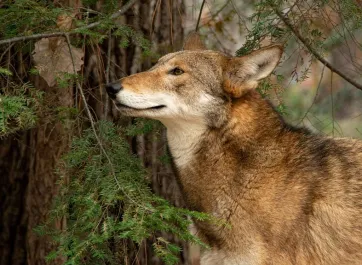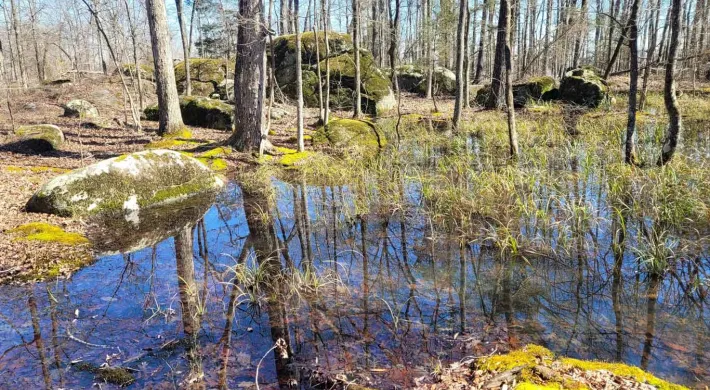Very Special American Red Wolf Adoption
This special adoption celebrates these momentous births. Your purchase (which provides a tax-deductible donation to the North Carolina Zoo Society) will help the Zoo continue to expand its American Red Wolf breeding facilities and its efforts to restore these wolves to the wild.
More on Expanding the Red Wolf Pack
The North Carolina Zoo is central in efforts to save the American red wolf from extinction. Once the southeastern United States’ apex predator, American red wolf populations have declined so dramatically that the species depends on breeding under human care to maintain a healthy, genetically viable population. By housing the second-largest pack of breeding American red wolves in the world, the Zoo is helping to ensure the survival of this species. The Zoo also coordinates the larger Red Wolf Recovery Program, which includes 45 other institutional partners. This role involves spearheading landowner outreach in eastern North Carolina, where the last 15-30 wild American red wolves live, and searching for a second recovery area where this iconic species can again fill its rightful place in the wild.
One of the World’s Most Endangered Canids
Once the southeastern United States’ apex predator, hunting, and habitat destruction had pushed the iconic American red wolf to extinction in the wild in 1980. The loss of this iconic species and the extinction of the Eastern cougar (the region’s other apex predator) led to major ecosystem changes, notably the deer population's rapid growth and coyotes' colonization. The US Fish and Wildlife Service (USFWS) initiated a captive breeding program at the Point Defiance Zoo in Washington State to save the last remaining American red wolves. The American red wolf population alive today, consisting of about 265 wolves under human care and about ~22 wolves in the wild, originated from this program founded with only 14 individuals.
A Successful Breeding Center
Today, the North Carolina Zoo plays a central role in the captive breeding efforts for the American Red Wolf Recovery Program. The Zoo’s American red wolf pack has bred 11 litters with 42 puppies from 2016 to 2023. Many of these pups have been transferred to contribute to breeding programs at other institutions. About 25 American red wolves are housed at the Zoo (this number is constantly in flux). Most of these animals are kept behind the scenes to allow these sensitive carnivores to retain their fear of humans and stay wild in preparation for possible future opportunities for release. Two ambassador red wolves live in the guest-viewing habitat in the North American region.
Mixed Results on Reintroduction
One of the core missions of the North Carolina Zoo is for animals housed at the Zoo to contribute to the survival of wildlife in their native habitats. The red wolf is no different; some animals raised at the Zoo formed part of the only wolf population present in the wild, reintroduced to the Alligator River National Wildlife Refuge in eastern North Carolina in 1987. In a groundbreaking effort to introduce new genetic material into a wild animal population, two pups born at the Zoo were carefully released and successfully fostered by wild American red wolves at Alligator River; this effort is now replicated to save the Mexican wolf from extinction. Due to these and other management efforts, the reintroduced population did particularly well initially, peaking at about 130 individuals in 2006. Unfortunately, pressures on the wild red wolf population (which include illegal hunting) increased in recent years. By 2017, this once-thriving population was reduced to about 30 animals.
Consequently, further reintroductions were halted in 2015, putting the future of this charismatic animal in the wild in jeopardy. Starting in 2021, USFWS restarted releasing red wolves into the wild. As of the end of 2023, there are 11 collared wolves in Alligator River National Wildlife Refuge with an estimated population of 21-23 red wolves. Six red wolves were born in the wild in the spring of 2023, the first litter since 2018.
Expanded Housing for Greater Impact
The setback at Alligator River has not stopped the passionate conservationists from working towards securing a future for the wolves. It only motivated them more to secure this species’ future. As part of an American red wolf recovery reassessment, the US Fish and Wildlife Service identified the need to double the current human-managed population before further wild reintroductions occur. The North Carolina Zoo plays an important part in this population expansion. The Zoo doubled the space dedicated to its red wolf breeding program thanks to $50,000 from the US Fish and Wildlife Service and $15,000 from the Emily Millis Hiatt Foundation Fund. This expansion has allowed the Zoo to house the world’s second-largest group of American red wolves, with future expansion plans aimed at making the Zoo’s wolf pack the largest in the world.
A Coordinating Partner
The Zoo participates in the Red Wolf SAFE Program, administered through the Association of Zoos and Aquariums (AZA). SAFE (Save Animals From Extinction) focuses on the collective expertise within AZA institutions and leverages their massive audiences to save species. This program also includes a breeding and population management program designed to ensure the long-term sustainability of captive-based animal populations. The North Carolina Zoo will maintain its active role in safeguarding the wolf population at Alligator River and assisting in expanding the American red wolf population under human care.
Partners: Red Wolf Coalition, Red Wolf SSP (with 43 other partner zoos and institutions), US Fish and Wildlife Service



